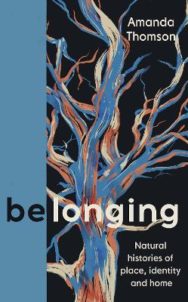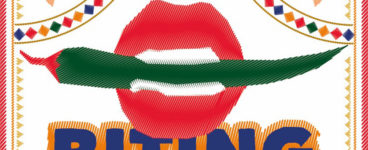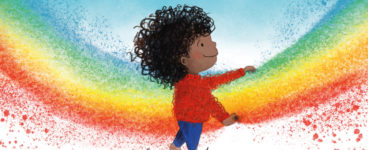‘I also held questions about the identities we perhaps each hold in a myriad of ways, and what it means to belong, and, perhaps, what might stop us from belonging.’
be/longing is a love letter to nature, and the through thread of Amanda Thomson’s life. Bringing together various elements from memory, to artwork and photography, the memoir explores how place language and family can shape us and make us who we are. Amanda tells Books from Scotland a little more about her new book.
be/longing: Natural Histories of Place, Identity and Home
By Amanda Thomson
Published by Canongate Books
Can you tell us a little bit of what we can expect from Belonging?
be/longing is a mixture of writing about nature, reflections on family and memory, and thinking about all the things which make places feel like home, and the things and people that make us who we are. If the book is part memoir, it’s also part biography of Abernethy forest, where I live. Abernethy forest is a huge area of remnant Scots pinewoods, which holds many rare and endangered species, and I write about Abernethy to think about what we mean by ‘home’, and what it is to long for a place, and what it is to belong.
You previously wrote A Scots Dictionary of Nature – how did you find the process of approaching and writing this book in comparison to this other style of non-fiction?
This book took far longer, but some of the chapters were written at the same time as pulling together the Scots words that make up A Scots Dictionary of Nature. In fact, it was writing the first book that sowed the seeds for this one, in that it was coming across Scots words that reminded me of my grandparents and that made me start to wonder more about them and other family members no longer with us. It was exciting and challenging putting belonging together, weaving together the threads of these different elements I found fascinating, thinking about our identities, tying past to present and personal to broader histories and experiences.
What is your own relationship to nature and the world around? Is it something that’s been present from a young age, or developed over the years?
I’ve always been connected to nature, beginning to birdwatch in my early teens, and starting hillwalking with a club in secondary school, but even before that, we would always go out on family walks, and though I wouldn’t have labelled it ‘nature’ as such, my childhood experiences were about being out and about walking or on my bike, going ‘up the glen’ or ‘over the hills’.
Nature as both a topic and genre acts as a great lens to explore a range of topics from the personal to political – how did you find telling your own story through with nature as a through thread?
It was interesting to do and I hadn’t set out to do that at first, but our connections to nature are so personal. At the same time, extrapolating personal experience to these bigger concerns and sometimes fears that we have about the world and where it’s going felt like something important for me to try to do. And also, when writing about nature, I start with writing about my experience of what I notice, and what it makes me think about, so it felt like a natural form for the book to take.
There are a lot of notions of memory and recollection in be/longing, particularly fitting for a memoir. How have you found your own relationship to memories shift as you worked on the book? Was everything vivid or did some re-emerge throughout the process that caught you by surprise? Or reshape how you look back on memories?
I’m surprised at how much I’ve forgotten, or more, perhaps, how fragmented memories are, and how much they are dictated by the photographs that we come across and return to, or the stories that are repeatedly told. It was lovely to go through a lot of family photographs with my mum and we’d compare memories, hers from an adult’s perspective, mine originally from when I was a child. I was reminded of some things that I had forgotten, and, in speaking with my mum, learned things about my grandparents and their generation that I had not known before. It’s nice to know now that in belonging, their ordinary lives are remembered in some way.
Your include a lot of Scots words and their definitions throughout – are there any particular favourite words or turns of phrase that you just particularly enjoy or think captures a nice feeling or sentiment?
I’ve loads, but a nice feeling or sentiment?
Flochter – to flutter, or to give free vent to joy
Flichtering-fain – throbbing with happiness
Weel-willed – kindly
What inspired you for this book?
In Scots pinewoods, the dead trees are an important source of nutrients for the living elements of the forest, and provide micro-habitats for its species. The idea of the continuing importance of what has gone before to the present, and acknowledging that ongoing influence, was something that I wanted to explore in relation to nature, but also, then, in thinking about my own history and family, race and identity. I also held questions about the identities we perhaps each hold in a myriad of ways, and what it means to belong, and, perhaps, what might stop us from belonging. I think there’s also something about getting older that makes us reflect back, but I’m also interested in what it is to take the time to pay attention and to notice what’s around you, and that’s what’s at the core when I write about nature.
What are you reading just now?
I’ve just picked up John Wilson Foster’s book Pilgrims of the Air, beautifully published by Notting Hill Editions – it looks like it will be a fascinating and thought-provoking read on the decline and extinction of the passenger pigeon in the USA at the beginning of the 20th century.
What do you hope readers take from be/longing?
I hope readers find the book thought-provoking and find interest in all kinds of ways – whether it gets them to consider their relationship to their own past, or reminds them of people no longer with them, or they learn something about Abernethy forest, or Culbin in Morayshire, Mingulay, Cape Town or the other places I encounter in the book. Hopefully readers will like how I’ve written about nature and what’s around us, and perhaps think about it a little differently. Also, perhaps, to think about what it is to make and to have a home, who makes us who we are and maybe, how lucky we are to live in Scotland – for all its faults, it’s an amazingly stunning country, and we should cherish it.
be/longing: Natural Histories of Place, Identity and Home by Amanda Thomson is published by Canongate Books, priced £16.99
















